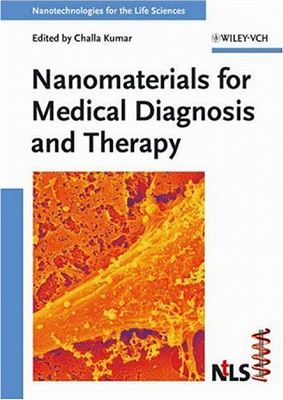Wiley, 2007. - 744 p. - Following an overview of nanotechnologies
for diagnostic purposes, this book goes on to look at
nanoparticle-based magnetic resonance, molecular and other imaging
applications, as well as the potential roles of carbon nanotubes
and bionanoparticles in biomedical applications. The book's main
focus is on drug delivery systems based on nonporous and nanosize
materials, solid lipid and polymeric nanoparticles, intelligent
hydrogels, core-shell nanoparticles, and nanocapsules, rounded off
by a discussion of their biomedical applications. The final part of
this volume covers such biomedical strategies as gene therapy,
synthetic gene-transfer vectors and targeted delivery.
From the contents:
Chapter 1: Nanotechnologies for Diagnosis - Present and Future.
Chapter 2: Superparamagnetic Nanoparticles of Iron Oxides for Magnetic Resonance Imaging Applications.
Chapter 3: Carbon Nanotube-based Vectors for Delivering Immunotherapeutics and Drugs.
Chapter 4: Core-Shell Nanoparticles for Drug Delivery and Molecular Imaging.
Chapter 5: Nanotechnologies for Targeted Delivery of Drugs.
Chapter 6: Nanoporous and Nanosize Materials for Drug Delivery Systems.
Chapter 7: NANOEGGTM Technology for Drug Delivery.
Chapter 8: Polymeric Nanomaterials - Synthesis, Functionalization and Applications in Diagnosis and Therapy.
Chapter 9: Polymeric Nanoparticles for Drug Delivery.
Chapter 10: Solid Lipid and Polymeric Nanoparticles for Drug Delivery.
Chapter 11: Intelligent Hydrogels in Nanoscale Sensing and Drug Delivery Applications.
Chapter 12: Nanoshells for Drug Delivery.
Chapter 13: Bionanoparticles and their Biomedical Applications.
Chapter 14: Nanotechnology for Gene Therapy - HVJ-E Vector.
Chapter 15: Nanotoxicology of Synthetic Gene Transfer Vectors: Poly(ethyleneimine)- and Polyfectin-mediated Membrane Damage and Apoptosis in Human Cell Lines.
Chapter 16: Nanoparticles for the Treatment of Alzheimer's Disease: Theoretical Rationale, Present Status and Future Perspectives.
From the contents:
Chapter 1: Nanotechnologies for Diagnosis - Present and Future.
Chapter 2: Superparamagnetic Nanoparticles of Iron Oxides for Magnetic Resonance Imaging Applications.
Chapter 3: Carbon Nanotube-based Vectors for Delivering Immunotherapeutics and Drugs.
Chapter 4: Core-Shell Nanoparticles for Drug Delivery and Molecular Imaging.
Chapter 5: Nanotechnologies for Targeted Delivery of Drugs.
Chapter 6: Nanoporous and Nanosize Materials for Drug Delivery Systems.
Chapter 7: NANOEGGTM Technology for Drug Delivery.
Chapter 8: Polymeric Nanomaterials - Synthesis, Functionalization and Applications in Diagnosis and Therapy.
Chapter 9: Polymeric Nanoparticles for Drug Delivery.
Chapter 10: Solid Lipid and Polymeric Nanoparticles for Drug Delivery.
Chapter 11: Intelligent Hydrogels in Nanoscale Sensing and Drug Delivery Applications.
Chapter 12: Nanoshells for Drug Delivery.
Chapter 13: Bionanoparticles and their Biomedical Applications.
Chapter 14: Nanotechnology for Gene Therapy - HVJ-E Vector.
Chapter 15: Nanotoxicology of Synthetic Gene Transfer Vectors: Poly(ethyleneimine)- and Polyfectin-mediated Membrane Damage and Apoptosis in Human Cell Lines.
Chapter 16: Nanoparticles for the Treatment of Alzheimer's Disease: Theoretical Rationale, Present Status and Future Perspectives.

